An amazing discovery from the good folks at the Internet Archive. Visit the Off Bunker Hill list, where LA historians and former Bunker Hill residents have been identifying structures and dating vehicles. One person even thinks they’ve spotted their father leaning on a lampost!
Tag: 100 Block
The Countdown Begins
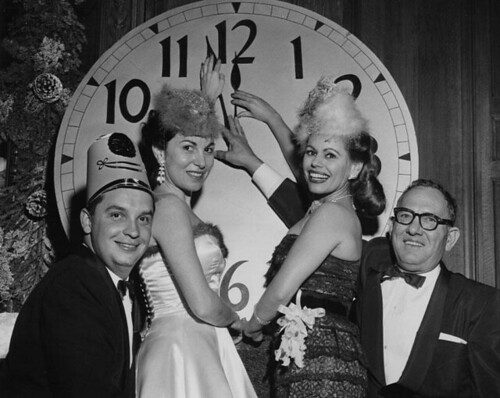
Happy Holidays
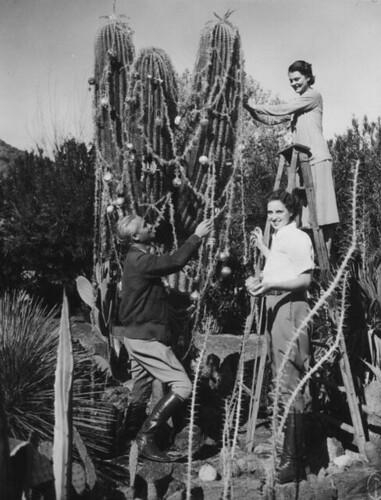
Walker Evans visits First & Flower
A glance at mid-century America reveals it emblazoned with the familiar totems: military might, industrial supremacy, cultural imperialism. These were carved by fervent if not blind progress, and you‘d be given a funny look (if not worse) were you to dare question that.
Nobody would dare bat an eye as freeways forever cut up cities, and huge swaths of our collective memory were lost to parking lots and well-intentioned developments. Funny old buildings were the realm of mutants, after all.
But even in the glory days of unquestioned, unfettered forward movement–before, say, Dallas ‘63 and Watts ‘65–there was a small rumbling of (not unpatriotic) discontent. Landmarks were lost hand over fist but when in 1962 it came time for Penn Station to become so much New Jersey Medowlands landfill, eyebrows were raised. This was Penn Station, after all. Somebody at Life magazine (somebody who ambled through Penn Station to the Life offices at Rockefeller Center, most likely) realized that losing our common heritage would make a nifty nine-page spread. And so Life called upon heavyweight photojournalist Walker Evans to do the immortalizing.
Walker shot in New York, as well as Norwalk, Conn; Boston and Amesbury, Mass; then out to California for Nevada City, San Francisco, and, in October of 1962, Los Angeles. Where he made a beeline to Bunker Hill. He shot all over the Hill but curiously took his greatest number of shots of 101 South Flower, and it was 101 South Flower that made it into the magazine:
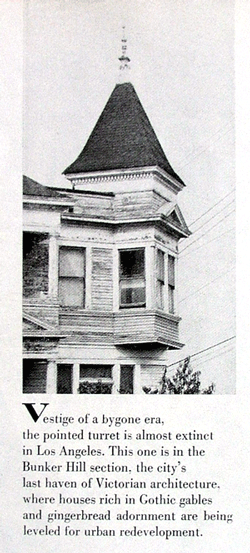
What can be said of 101-109, aka 101-111 South Flower? Precious little. We know that it is announced in February of 1904, to run $16,000 ($364,809 USD 2007).

But a thorough check of its various addresses shows that nothing of consequence ever there occurred.
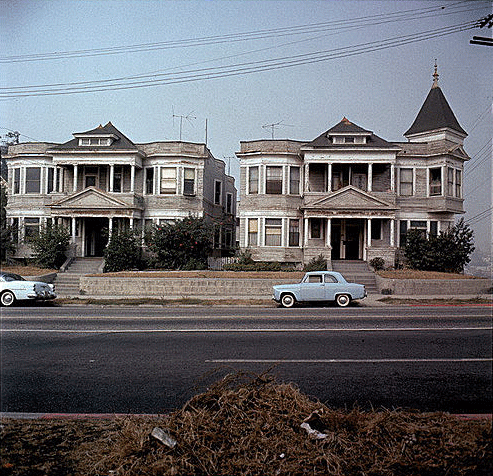
The southwest corner of First and Flower:

 Sure, there was the small matter of Clifford Gooding, who‘d married his gal Marie and had a daughter with her, only to disappear after a few years. Marie heard Clifford was dead, and so she remarried, only Clifford wasn‘t dead, just”¦disappeared. To Bunker Hill. She lived down on 37th Street; Bunker Hill may as well be the moon. After six years of Clifford being “deceased” she caught wind that he wasn‘t, had him tracked down, and he was popped at our First & Flower apartment house in November 1925 on a deadbeat dad charge. That‘s about as racy as it gets; that, and the residents of this particular place had a terrible habit of stepping off of this curb and that into fatally well-built oncoming automobiles.
Sure, there was the small matter of Clifford Gooding, who‘d married his gal Marie and had a daughter with her, only to disappear after a few years. Marie heard Clifford was dead, and so she remarried, only Clifford wasn‘t dead, just”¦disappeared. To Bunker Hill. She lived down on 37th Street; Bunker Hill may as well be the moon. After six years of Clifford being “deceased” she caught wind that he wasn‘t, had him tracked down, and he was popped at our First & Flower apartment house in November 1925 on a deadbeat dad charge. That‘s about as racy as it gets; that, and the residents of this particular place had a terrible habit of stepping off of this curb and that into fatally well-built oncoming automobiles.
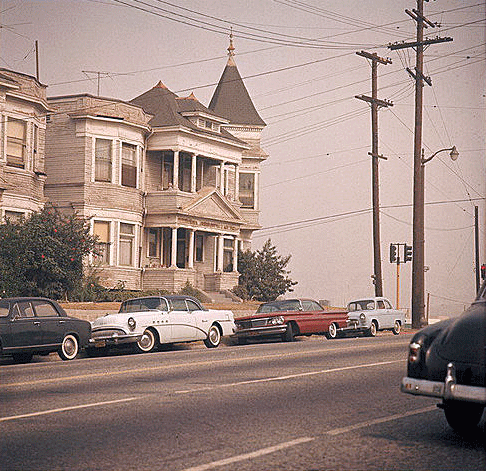
Fortunately what we lack in drama we make up for in image quantity. It was captured of course by the incomparable Arnold Hylen:
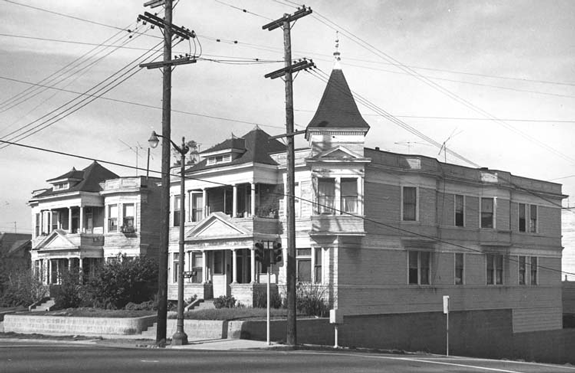
Today, of course, the building is demolished, but one isn‘t always expecting to find the same thing to have happened to the street. Where has all the Flower gone?
In each of the two images below: First at the top, Second at the bottom, Figueroa at the left (yes, I know Fig is a Street and not an Avenue, that‘s Baists for you) Hope on the right. In the top image, Flower runs down the middle, and there‘s 101 in orange, with “Labarere Tr.” (for Labarere Tract) written across it. In the modern image below, well Flower just went away.
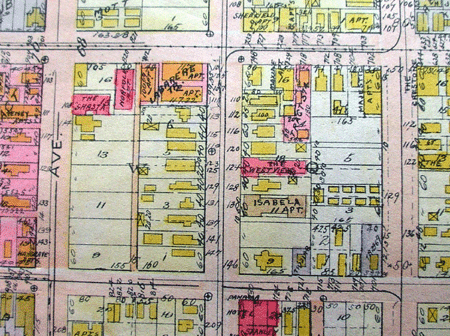

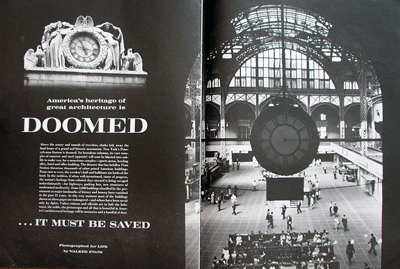 A few final words about Life‘s Doomed Architecture article, published July 5, 1963, and which noted that “some 2,000 buildings classified by the government as major landmarks of history and beauty have vanished in the past 25 years.”
A few final words about Life‘s Doomed Architecture article, published July 5, 1963, and which noted that “some 2,000 buildings classified by the government as major landmarks of history and beauty have vanished in the past 25 years.”
Penn Station, of course, is demolished. This action is largely credited for impregnating America with preservation consciousness. This isn‘t true, of course, but that‘s ok.
In writing about the Amesbury, Mass. Rocky Hill Meeting House Life notes that a proposed expressway is taking down three 18th-century buildings and coming within yards of the structure, which is in a state of miraculous state of preservation. This writer does not know if the 1963 worries about blasting and vibrations undermined the building, or played havoc with the 1780s glazing, but I do know that the 495 is now a stone‘s throw away, and I call that wrong.
Nevada City, best extant example of a Gold Rush town, was to be partly lost when the four-lane CA-20/49 bisected the little burg. But the “outraged local groups” apparently persuaded authorities to shift the highway, saving the most historic buildings, which thus now stand to this day.
After the Mathews Mansion was foolishly given to the City of Norwalk, Conn, the City embarked on a period of Official Neglect until they could plead “It Can‘t Be Fixed!” and set out to demolish it for a city hall. After a three-year battle, citizens saved the mansion by referendum; the city ignored this and set out to build the city hall on the mansion grounds again. Eventually, though, the mansion was saved, we hope for some time.
The 1874 Greek Revival San Francisco Mint was also a victim of Official Neglect; the city thought it a swell place for a parking lot, and had let it deteriorate to the point of its roof collapsing. Its demolition was slated for 1965; as can be seen, that did not happen.
And so while the vast majority of the subjects in Life‘s article survived to see another millennium, 101 South Flower did not. Nor did any of the any other structures shot by Evans that Los Angeles October.
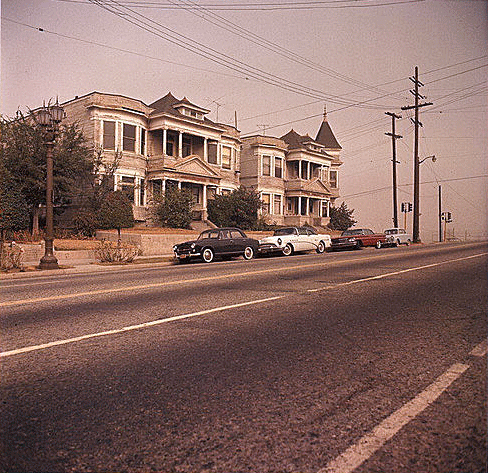
Bow, Wow, WOW!

December 2, 1923
133 South
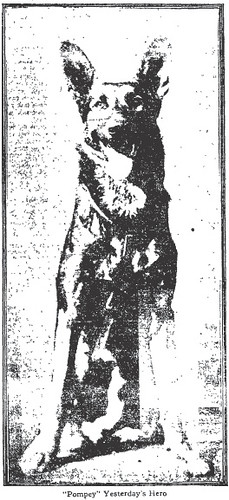 We humans may be nasally challenged with our measly 5 million scent receptors, but German Shepherds have 225 million ”“ and they know how to use them all. With that kind of super hero sniff power, it was no surprise when a German Shepherd named Pompey caught the aroma of gas fumes, desperation, and imminent death in the air. The surprise was that he was galvanized into action.
We humans may be nasally challenged with our measly 5 million scent receptors, but German Shepherds have 225 million ”“ and they know how to use them all. With that kind of super hero sniff power, it was no surprise when a German Shepherd named Pompey caught the aroma of gas fumes, desperation, and imminent death in the air. The surprise was that he was galvanized into action.
Pompey and his mistress, Mrs. Mitalzo, were out for a stroll on
The 24 year old Stark had just been discharged from his job as an elevator operator at a downtown hotel. Management had told him that he was through because he didn”™t close the elevator doors properly. The despondent man had taken several newspapers and fashioned them into a long cone. He placed the small end of the improvised suicide device over a gas jet in his room, and he placed the large end over his face. Stark then turned on the gas and lay down to die.
When Pompey entered the room, Stark was unconscious and near death. The valiant dog dragged the motionless Stark into the safety of the hallway. Mrs. Mitalzo ran into the rooming house to search for Pompey and discovered him watching over the dying man.
Police were summoned and Stark was taken to the
Pompey vanished from the pages of the Los Angeles Times after his brief moment in the limelight, but his famed counterpart, Rin-Tin-Tin, was just beginning his film career in 1923.
Rin-Tin-Tin was only five days old when he was rescued from a bombed out kennel in
Rin-Tin-Tin (aka Rinty) was seen performing in a local dog show by movie producer Charles Jones ”“ and a star was born. Rinty worked hard and would often relax by listening to the radio.
His career lasted for over a decade and eventually earned him a star on the Hollywood Walk of Fame. Rinty passed away quietly in his sleep at the ripe old age of 14.
Carelessness, deadly and not
Location: 121 North Flower Street
On December 10, 1925, road crew worker W.A. Conway of this address demonstrated exactly how tough were the inhabitants of Bunker Hill. He began the day getting blasted in the head by a misplaced explosive charge on the Edward Lynch property on North Louise Street in Glendale, resuming work after receiving six stitches. Not long after his return, steam shovel engineer Tom Adams told powder man L.J. Starkey to set off a charge of black powder in the hole. The explosion destroyed the steam shovel, sent rocks and debris raining down, and was dropped souffles all over Glendale. Conway was unhurt by this second blast, but we hope he took the hint and found a more careful crew to work with.
On January 3, 1935, A.E. Kelly of this address had the dubious distinction of being the agent of death for Harold Wilburn, aged 60, who stepped in front of Kelly’s automobile at Fifth and Wall Streets. The accident was explained as caused by the victim being "confused by traffic," but the location of the incident (the corner anchored by the notorious Hard Rock Cafe) suggests Mr. Wilburn may have been lit up like a Christmas tree before stepping out into oblivion.
I Want to Live!

121 North Flower Street
April 15, 1953
The most sensational trial of 1953 has to have been that of Barbara Graham. The defendant was accused, along with Jack Santo, Emmett Perkins, Baxter Shorter, and John True of the beating death of Mrs. Monahan during a home invasion robbery. The crime itself was so banal that it may not have made it to the front page of the LA Times at all, and it definitely wouldn”™t have stayed there for as long as it did had it not been for Barbara, an attractive 29 year old prostitute and drug addict.
The story had all of the elements of a lurid tale from a sleazy detective magazine. Barbara Graham, abandoned by her  teenaged mother in
teenaged mother in
The crime itself was apparently the result of misinformation given to Perkins. He was told that Mrs. Monahan (former mother-in-law of Las Vegas gambler Tutor Scherer) had a sack full of money and jewelry that she kept in her home (the same kind of tragic misunderstanding would result in the brutal murder of the Clutter family in Kansas in 1959, and become the subject of Truman Capote”™s brilliant novel, “In Cold Blood”).
On the night of March 9, 1953, the gang drove to Mrs. Monahan”™s home in
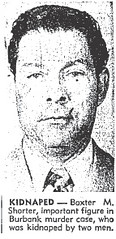
It wasn”™t until the suspects had been identified and arrests had been made that the tale would take a turn onto
Baxter and his wife Olivia lived in an apartment at 121 N. Flower, and it was from that location that Shorter was kidnapped by two men. In a photo shown to her by police, Olivia identified one of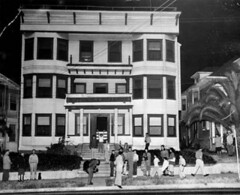 the kidnappers as Emmett Perkins. The other man was almost certainly
the kidnappers as Emmett Perkins. The other man was almost certainly
Barbara maintained her innocence until the end. Being a mother of three, she may have avoided the death penalty if she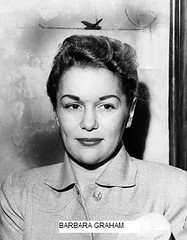 hadn”™t made the mistake of offering a fellow inmate $25k to provide her with an alibi for the night of the murder. Unfortunately for her, the cellmate was actually a cop, planted to befriend her and gather information. Barbara”™s blunder had doomed her to death. Santo, Perkins, and Barbara would all die in San Quentin”™s gas chamber on the same day.
hadn”™t made the mistake of offering a fellow inmate $25k to provide her with an alibi for the night of the murder. Unfortunately for her, the cellmate was actually a cop, planted to befriend her and gather information. Barbara”™s blunder had doomed her to death. Santo, Perkins, and Barbara would all die in San Quentin”™s gas chamber on the same day.
Graham”™s execution was the paradigm for cruel and unusual punishment and would be the topic of many impassioned editorials, even by supporters of the death penalty. On the morning of her execution she”™d dressed in a beige wool suit and brown pumps, and had tried to prepare herself to face death. She was scheduled to die at 10:00 am on June 3, 1955, but was granted a stay until 10:45 am. Her execution would be delayed one more time, causing Barbara to ask “Why do they torture me?” Finally at 11:28 am Barbara was blindfolded at her request, and was led from the holding cell to the gas chamber.
In a macabre moment the executioner, Joe Feretti, gave the condemned woman a bit of advice: “Now take a deep breath and it won”™t be so bad” ”“ to which she replied, “How the hell would you know?”
For a fictionalized account of Graham”™s story, rent a copy of the 1958 film, “I Want to Live!” starring Susan Hayward.
Bad, Bad Edna Brown
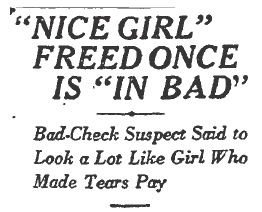
December 6, 1922
Edna Brown, aka Edna Chaplin, aka Mabel Austin, seemed like such a nice girl. Sure, she”™d been busted by Detective Sergeants Bartley and Allen for stealing $100 ($1,271.00 current USD) from O. Johnson”™s apartment at 124 South Bunker Hill Avenue, but Edna did the right thing and confessed to the crime, resulting in her being charged with grand theft and larceny.
When she appeared in Judge Hinshaw”™s court for her arraignment, she burst into tears and appeared to be so genuinely remorseful that Guy Eddy, an attorney who was present on another matter, came to her defense and made a motion to dismiss the case. Judge Hinshaw was also moved by the girl”™s tears, and since Deputy District Attorney Orme made no objections, Edna walked.
Apparently none of the well meaning men in the courtroom ever thought to question why such a seemingly nice girl would have at least two known aliases.
A few days following Edna”™s day in court, Detective Sergeants Bartley and Allen were on the trail of a girl who had been accused by J.S. Purdy of using his name to pass bad checks. Purdy told the cops he suspected a girl named Edna. When he was shown a photo of Edna Brown, he immediately identified her as the forger.
Note to Guy Eddy, Esq., Deputy District Attorney Orme, and Judge Hinshaw ”“ no good deed goes unpunished.
Gregory Perez survives construction collapse, 1915
Location: Cinnabar Street between First and Second Streets
Date: March 19, 1915
Construction worker Gregory Perez narrowly escaped death when the dirt walls of the apartment house basement he was excavating for contractor Philip Younger collapsed on top of him. Trapped beneath tons of dirt, he was protected by a network of collapsed wooden banks which came to a point above him. His frantic colleagues were able to introduce a sharp stick through the soil, letting sufficient air in that Perez was able to offer encouraging commentary during the struggle to free him, and after four hours he emerged, grateful and uninjured, into the light of day







